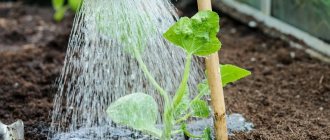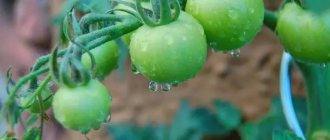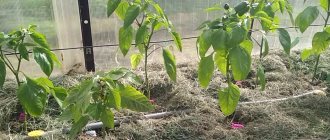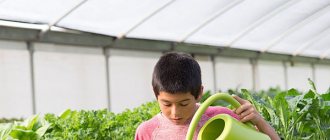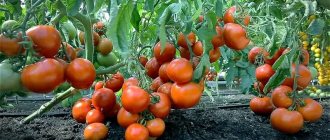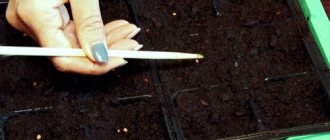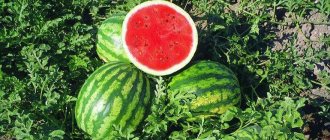Pepper is a heat-loving and capricious crop, so it is not easy for gardeners living in cold climates to grow it. It is important to create optimal growing conditions, apply fertilizing correctly and in the right amount, and most importantly, choose the right watering regime.
In this article we will tell you how often to water peppers in a greenhouse and what gardeners who grow this crop in a greenhouse should remember.
Features of watering peppers in a greenhouse
Different varieties of peppers differ not only in taste and appearance, but also in their growing season. That is why their care should be different. The main requirements suitable for any variety are that the water for irrigation should not be very cold and the soil should be kept constantly moist. Proper watering is very important, because from a lack of water the fruits will be hard and dry.
Water composition and temperature
Peppers are watered with warm water, but this does not mean that it needs to be heated. It is enough to place a large barrel in a sunny place on the site. If the weather is hot, then watering is done in the morning, but if it is cool outside, then irrigation is done in the evening.
It is best to water the plants not with tap water, but with well water, which must first be settled. It contains important microelements that promote growth and fruiting. Another option is to add mineral fertilizers to the water for irrigation.
How often and correctly to water peppers in a greenhouse at different stages of their growth
To ensure that the harvest does not disappoint, when watering it is necessary to take into account the growth phases; in this case, optimal conditions for the development of the plant are provided.
Bloom
The roots of peppers are small and shallow. Flowering (usually in late June-early July) takes a lot of energy from the plant, so you need to water more often. The ideal option is twice a week. The average water requirement is 2 liters for each bush.
The amount of water depends on the temperature. When it goes up, it needs to be increased, when it goes down, it needs to be reduced. If the greens begin to wilt, more water is also required, otherwise the flowers will begin to fall off. But it is important not to overdo it to prevent the formation of stagnant water.
Fruiting
When the fruits begin to ripen (late July-August), you need to water more often, but less. Depending on the soil, variety, and air temperature, the frequency of watering is adjusted to once every two days.
Once the peppers are ripe, they need to be watered every 3-4 days. Low-growing plants require 2 liters of water at a time, tall plants - 4-5 liters.
To protect the soil from drying out, you can mulch it with organic matter - grass clippings, hay, wood chips.
Disembarkation rules
Proper care of peppers in a polycarbonate greenhouse begins at the moment of planting. At the first stage, it is necessary to take into account the correct geometry of the beds:
- a “two-line tape” scheme is used - in a bed 30-35 cm wide, seedlings are planted along the edges opposite each other or in a checkerboard pattern;
- if there are several rows of ribbons in the neighborhood, a distance of at least 70 cm is maintained between them for convenient movement along the beds during the process of care, fertilizing, and watering;
- the distance between seedlings is at least 20 cm.
In order for the seedlings to grow well, the soil is constantly loosened to enrich it with oxygen - a necessary element for growth and nutrition of the roots.
Maintaining a temperature favorable for peppers in the greenhouse
All varieties of bell pepper are dependent on temperature changes. In order for a vegetable crop to develop well and bear fruit abundantly, the temperature inside the greenhouse during planting and during active growth should be about 22°C, and during fruit ripening it can be increased to 25-27°C.
Methods for watering peppers in a greenhouse
The methods by which irrigation is carried out may vary. When making a choice, you need to take into account the size of the greenhouse and the variety of peppers.
Auto
A “smart” greenhouse saves its owners time and effort. It is possible to automate not only watering peppers in a greenhouse, but also ventilation, lighting levels, and air temperature. Irrigation in this case is most often done using the drip method. This option saves water and is characterized by uniform supply. The soil is properly moistened, which affects the harvest.
Additional convenience - remote control. The downside is the fairly high cost. A pump connection or water intake from a water supply system is required.
Mechanical
This is a similar option, but easier to maintain. A large tank is installed next to the greenhouse, which should be located as high as possible. Plastic pipes connected to the tank are laid along the beds. Drip tapes connect the pipes to the plants.
This method has undeniable advantages:
- Economical use of water.
- Less time is spent on watering.
- Watering is done evenly, the soil is kept moist.
- Watering is conveniently combined with fertilizing. Just pour the fertilizer solution into the tank.
But there are also disadvantages. Constant monitoring is required to ensure that the water pressure remains at the proper level. Drippers often become clogged with soil particles, so the system needs to be cleaned regularly.
Manual
If the greenhouse is small, then there is no point in installing an expensive irrigation system. In this case, manual watering is used using an ordinary watering can. In order not to harm the plant, you need to make sure that water does not get on it. In addition, it is unacceptable to pour water in a strong stream in large quantities, otherwise it will lead to erosion of the soil.
Combined
Watering can be successfully organized by combining manual and automatic control of the irrigation system. This is advisable in cases where the power supply is unstable, crop watering regimes vary, and the water pressure is weak enough for good irrigation.
The disadvantage of such a system is its high cost. It is necessary not only to equip the automation, but also to install a large container for collecting water.
Sprinkler
This is watering that simulates raindrops. Not the most popular option, as it is not recommended for use on sunny days, during flowering and in a greenhouse, as it causes excessive humidity.
Drip
The ideal way to irrigate peppers. Water is supplied directly to the root; fertilizers do not reach the shoot. Along the beds, pipes are laid on the soil, having a small hole opposite each bush. Water is supplied through them and seeps through the holes to the plants.
Getting your own seeds
Among the peppers grown in a greenhouse, there will always be 1-2 varieties that you will want to see in your garden next season. And you need to prepare your favorite specimens in advance.
First of all, mark them by tying a bright ribbon to the stem, otherwise one of the household members will definitely snap at the beauty without leaving the bed.
Pure varietal peppers are suitable for collecting seeds. Fruits grown from seeds marked F1 are not suitable for collecting seeds: they do not retain maternal qualities.
The seeds are left with the fruit grown from the crown bud or 1-2 fruits from the first order branches. The seeds of these peppers will be the healthiest and most germinating. It is desirable that the fruits reach biological maturity directly on the root.
It is then picked and left to ripen indoors. The seeds can be removed when the fruit loses its elasticity and the skin becomes wrinkled.
Using a sharp knife, carefully cut the walls of the pepper along the fruit and take the seeds that are located closer to the stalk.
You can immediately check for occupancy:
- The grains are placed in a glass of water and those that are on the surface are removed.
- Those that have precipitated are laid out to dry.
- After 3-5 days, they are packaged in a paper bag and labeled with the variety and date of collection.
Pepper seeds remain viable for 3-4 years.
This shelf life will allow you to grow your favorite variety, even if it is not on the shelves of specialized stores at the right time.
The nuances of watering peppers in different types of greenhouses
Irrigation of pepper depends not only on the plant variety, but also on the greenhouse in which it is located.
How to water peppers in a polycarbonate greenhouse
Such greenhouses are most widespread among gardeners. They are easy to use, durable, transmit sunlight well and retain heat inside well.
The greenhouse should be ventilated as often as possible, thus controlling air humidity. You should not grow both bitter and sweet peppers in close proximity to each other. This will ruin the taste and sweet varieties will become bitter.
When using a mechanical watering method, you should not lay soft pipes in the greenhouse. The fact is that they can burst if they cannot withstand the pressure of water. During ripening, watering the plants stops. The less moisture there is, the faster the fruits will reach ripeness.
How to water peppers in a greenhouse under film
Such structures are small in height and do not provide the ability to regulate the temperature inside. Therefore, peppers planted in such a greenhouse must be watered with heated water if the temperature outside drops.
After planting the seedlings (late May-early June), watering must be done very carefully so as not to over-moisten the soil and damage the fragile roots of the seedlings. A single dose of water for one plant is approximately 100 ml, it must be watered every day. Good results are obtained by mulching the soil, which helps normalize air humidity and temperature. The mulch layer should reach 7-10 cm.
Growing conditions
Before moving on to the issue of watering peppers in a greenhouse, it is worth finding out the basic growing conditions.
In open ground, vegetables will grow only in areas with a warm climate. In other regions of our country, peppers are grown in greenhouses. Recommended air temperature: +18…+25°C.
Since fruits love light, the greenhouse material must be translucent. Otherwise, you will not get the harvest you expect.
Use the necessary fertilizers (mineral and organic) for growth. It is good if the soil contains organic substances such as black soil or compost.
Don't forget to follow the irrigation rules.
Reference. Bitter and sweet (Bulgarian) fruits require the same conditions of maintenance and watering.
The combination of watering and fertilizing peppers
Peppers are fertilized approximately once every 2-4 weeks. It is convenient to dissolve the fertilizer in water for irrigation.
In spring, plants are fed with nitrogen fertilizers; they have a good effect on the growth and development of shoots. But you should not abuse them, otherwise the harvest will contain an excessive amount of nitrates. Potassium and phosphorus substrates will come in handy in the fall.
To obtain a good harvest, potassium solution is added to the water in a ratio of 1:10. You can use chicken manure in a ratio of 1:12. Five liters of this solution is enough to water 1 m² of soil.
The use of wood ash has proven itself well. You will need approximately 150 g per square meter. Nettle infusion will provide protection from diseases and pests.
It is important to remember that peppers prefer balanced fertilizers, which must contain urea (about 10 g) and superphosphate (half as much).
Keep the beds clean
Since there is much less space in an enclosed space, plants have to be placed close to each other. Close proximity of plants and high humidity are the main risk factors for the development and rapid spread of various diseases. That is why it is important to weed the plantings in a timely manner and get rid of uninvited green “guests”.
Sometimes it happens that another one “breaks through” into the territory that you have allocated for growing one crop. If it just so happens that another “decent” plant has settled next to your peppers, do not rush to get rid of it.
For example, onions and garlic will help repel pests and suppress the growth and development of pathogenic bacteria, and basil, marigolds, coriander, catnip, marjoram, tansy and thyme will attract pollinating insects to the plant.
It is interesting that weeds can also play a good service for your harvest. For example, nettle, chamomile and dandelion contribute to the speedy ripening of vegetables. If there are 1-2 specimens of one of these plants in a greenhouse with peppers, it makes sense to postpone fighting them until the end of the season, when you have already harvested the entire crop.
- A good neighborhood: what can be planted next to peppers
Not all vegetables get along well in one bed. Today we are choosing neighbors for our beloved bell pepper.
When to stop watering peppers in a greenhouse
Peppers need watering almost the entire time they are growing. The exception is during harvest time. It is believed that this technique allows you to prolong the growing season, stimulate the appearance of new flowers and wait for another harvest.
Healthy! If your peppers are attacked by aphids, treat them with a solution of laundry soap (300 grams) dissolved in warm water (10 liters), for a better effect you can add 1 tbsp. soda Also note that aphids live in symbiosis with ants; you can get rid of the latter by watering their clutches with boiling water.
Improper watering of pepper and its consequences
Many gardeners who do not have sufficient experience adhere to the “more is better” attitude when watering, especially if the weather is hot. This is a fundamentally wrong opinion.
Excess water will not harm the plant only if watering is done early in the morning. Then, by mid-day, the water will have time to soak into the soil, and the pepper will not be harmed.
But waterlogging the soil in the middle of the day poses a serious threat to plants. The fact is that the drops remaining on the shoot play the role of many magnifying glasses. The leaves suffer from severe burns.
The water does not have time to evaporate, so a hard crust forms on the soil. The roots begin to dry out, which can lead to the death of the shoot. A plant experiencing excess moisture grows poorly, drops flowers, and does not form an ovary.
Tips from Mister Summer Resident
- Water for irrigation should be moderately warm and settled.
- After the shoots have finished developing, fertilizers are added to the water.
- A good fertilizer is manure diluted in water. One part of manure is dissolved in 10 parts of water. This fertilizing is applied not under the plant, but in the grooves between them.
- The addition of superphosphate and urea shows excellent results. For 10 liters of water, 10 g of urea and twice as much superphosphate are required. The amount of solution per bush is 500 ml.
- Pepper stems are quite fragile and often break off under the weight of the fruit. Therefore they need to be tied up.
- If the water is hard, you should add wood ash to it at the rate of half a glass of ash per bucket of water. This will achieve softness.
- The best option is rainwater.
- Sandy soils drain moisture well, so in this case you need to water more often.
- If you see a fungus on the glass of a greenhouse that has formed due to excessive watering, it must be removed immediately, since it is dangerous not only for the plants, but also for ourselves.
The dangers of waterlogging the soil
How often should you water your onion and garlic beds?
Leaving the soil dry for a long time when growing peppers is strictly prohibited. These are very moisture-loving plants that are difficult to tolerate dehydration. But it is not recommended to oversaturate the soil with moisture.
Land oversaturated with water contributes to the development of diseases of the root system, in particular, it can lead to its rotting. Also, watering should be stopped due to the fact that an excess of water provokes plant diseases of various etiologies.
Excess moisture can attract the well-known enemies of all summer residents - slugs. They feed on plants such as peppers and enjoy waterlogged climates.
Feeding peppers in a greenhouse: a few words
To make the harvest worth the effort and please the gardener, peppers must be fertilized. Let's consider optimal feeding schemes.
- Immediately after transplanting to a permanent place, seedlings are fertilized with an aqueous solution of mullein (1:10) or chicken manure (1:12). Consumption - 5 liters per square meter.
- Wood ash is added in the amount of 150 g per square meter.
- The fertilizer should contain urea (10 g) and superphosphate (5 g). Calculations are given for a bucket of water. You can add a few drops of iodine.
Many people think that growing a good pepper crop is difficult. But if you follow simple recommendations, success will await any attentive gardener.


